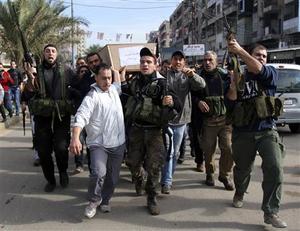SyriaIran builds 50,000-strong Syrian Alawite militia for post-Assad era
Officers from the Iranian Revolutionary Guard, aided by scores of Hezbollah officers, have been busy building, equipping, and training a new Alawite militia which will continue to protect Iranian and Hezbollah interests in Syria following the inevitable fall of Assad. The Assad regime already has a paramilitary militia, the shabiha, or “ghost,” units. The shabiha, together with Hezbollah fighters from Lebanon, has concentrated on killing Sunni civilians in villages and towns deep inside Alawaite-majority areas. Syria and Hezbollah, however, have been worried for a while that, at the end, the loyalty of the shabaiha is to the Syrian Alawaite minority and its interest. Iran and Hezbollah want to create a well-armed militia which will be loyal to the interests of Iran and Hezbollah. The new, 50,000-strong militia, called Jaysh fighters, is a purely sectarian fighting force overseen by Iranian and Hezbollah commanders and separate from the shabiha paramilitaries.

Syrian-Alawite militia clashes spill over into Lebanon // Source: el-wasat.com
With rebel forces now fighting within a few city blocks of downtown Damascus, and with the rebels gaining control over Syria’s largest hydroelectric dam, Iran, President Assad’s staunchest ally, is beginning to prepare for a post-Assad Syria.
Reports from Syria say that officers from the Iranian Revolutionary Guard, aided by scores of Hezbollah officers, have been busy building, equipping, and training a new Alawite militia which will continue to protect Iranian and Hezbollah interests in Syria following the inevitable fall of Assad.
The Independent reports that Iran and Hezbollah are preparing for the eventuality of the regime’s fall by building a 50,000-strong militia on the ground.
A senior Obama administration official told the Washington Post that the Iranian-Hezbollah effort to create a 50,000 Alawite militia is “a big operation…. The immediate intention seems to be to support the Syrian regime. But it’s important for Iran to have a force in Syria that is reliable and can be counted on.”
A senior Arab official told the Post that Iran’s strategy in Syria has two tracks. “One is to support Assad to the hilt, the other is to set the stage for major mischief if he collapses.”
Scholars agree. “Syria is basically disintegrating as a nation, similar to how Lebanon disintegrated in the ’70s to ethnic components, and as Iraq did,” said Paul Salem, director of the Beirut-based Middle East Center of the Carnegie Endowment for International Peace. “It’s going to be very hard to put Syria the nation back together.”
“We’re looking at a place which is sort of a zone, an area called Syria, with different powers,” Salem said.
The Assad regime already has a paramilitary militia, the shabiha, or “ghost,” units. The shabiha, together with Hezbollah fighters from Lebanon, has concentrated on killing thousands of Sunni civilians in villages and towns deep inside Alawaite-majority areas.
The goal is ethnic cleansing – the creation of ethnically homogenous Alawite areas which, if necessary, could serve as an independent ethnic enclave for the Alawites once their 40-year rule of Syria comes to an end with the fall of Assad.
Syria and Hezbollah, however, have been worried for a while that, at the end of the day, the loyalty of the shabiha is to the Syrian Alawaite minority and its interests.
Iran and Hezbollah want to create a well-armed militia which will be loyal to the interests of Iran and Hezbollah.
The Post notes that while the new militia, called Jaysh fighters, is ostensibly created to strengthen and support the overstretched, demoralized Syrian army, the Iranian have insisted on it being separated from the shabiha paramilitaries. The goal is to create a purely sectarian fighting force overseen by Iranian and Hezbollah commanders.
“Jaysh is essentially an Iran-Hezbollah joint venture,” David Cohen, undersecretary for terrorism and financial intelligence at the Treasury Department, told the Post. “Given the other constraints on Iranian resources right now, it’s obvious that this is an important proxy group for them.”
In a divided, post-Assad Syria, Iran’s natural allies would include Shiites and Alawites concentrated in areas near Syria’s border with Lebanon and in the key port city of Latakia.
Analysts say that a likely scenario would be for the remnants of Assad’s government, perhaps without Assad and his family, to try to establish a coastal Alawite enclave tied to Tehran and completely dependent on the Iranians for survival. This Alawite beachhead would allow Iran to continue to supply Hezbollah, thus retaining Iran’s ability to pressure Israel.
Iran’s main goal is no longer keeping Assad in power, a goal which is becoming less likely with every passing day. Rather, Iran wants to achieve four more important, and attainable, goals:
- Prevent the emregence of a stable, centralized Sunni-majority regime in Syria
- Continue to prevent the rise to power of an anti-Shi’ia, Sunni-dominated coalition in Lebanon
- Continue to provide military and economic support to Hezbollah
- Continue to exert pressure on Turkey to the north
These four goals can only be achieved if Iran continues to have access naval and military bases in Syria.
Salem said that the preservation of an Iranian-supported area on the coast has always been “Plan C or Plan D” for core regime supporters. “If everything fails and they lose, they have always prepared for the fortress region . . . with everything they can cart away, even if they lose Damascus.”
“That’s not necessarily what they want,” he said. “They want to hold on to the whole thing.” But the worst-case scenario is that “the whole regime relocates to the northwest, and they still have the most powerful [armed] unit inside Syria, with a lot of the current structure.”
